| Year | Population |
|---|---|
| 1970 | 313 |
| 1980 | 448 |
| 1990 | 593 |
| 2000 | 647 |
| 2010 | 664 |
| Geographic Data | |
|---|---|
| N. Latitude | 44:40:10 |
| W. Latitude | 69:54:24 |
| Maine House | District 108 |
| Maine Senate | District 3 |
| Congress | District 2 |
| Area sq. mi. | (total) 27.4 |
| Area sq. mi. | (land) 26.7 |
| Population/sq.mi. | (land) 24.9 |
County: Somerset
Total=land+water; Land=land only |
|
[MER-cer] is a town in Somerset County incorporated on June 22, 1804 from Industry Plantation.
The town lies on U.S. Route 2 just west of Norridgewock with frontage on North Pond at its southeast corner.
Between annexing land from Starks in 1835 and 1865, the town set off land to Smithfield and New Sharon (1840), and to Norridgewock (1849 and 1852).
First settled in the early-1780’s, it was named for Revolutionary War Brigadier-General Hugh Mercer.
The main village is centered around a long-gone grist mill site and the Mercer Bog, created in part by the dam on Bog Stream at the old mill site. The stream travels about seven mile to its mouth in the Sandy River.
It is the birthplace, in 1808, of U.S. Congressman James S. Wiley.
With forty-one residents in 1800, Mercer exploded to a population of 1,432 by 1840.
Soon thereafter, Maine’s first starch factory was established soon to be followed by another, which joined the saw, grist, shingle, and joiner’s mills and a tannery.
1840 was the peak for the town’s population. The Civil War period accelerated it’s decline with 207 people leaving for other parts of the country.
The library and the Grange are two surviving organizations formed in the late 19th century as the population continued to decline.
In 1813, ten separate school districts, the largest number before or since, provided education for approximately 140 of Mercer’s children. By 1892, a town system of education was established and the number of schools was limited to four.
The Congregational Meetinghouse, which still stands, was dedicated on June 11, 1829. However, the Methodist Vestry, built in 1860, was destroyed by fire in 1901. Reconstructed almost immediately, the new structure was restored to look exactly like the original.
In 2016 the Town Office and Community Center occupy the former elementary school that closed in 2009. Students now attend Mill Stream Elementary School on the Mercer Road in Norridgewock.
All photos taken in Mercer Village, unless otherwise noted.
Additional resources
Allen, William. History of Mercer, Maine. Mercer, Me. Mercer Historical Society. c. 1990 (reprint of his late 19th century account)
Maine. Historic Preservation Commission. Augusta, Me. Text from National Register of Historic Places.
Mercer Historical Society. Pictures and People of Mercer, Maine 1804-1985. Mercer. c.1985.
Smith, Harold Owens. The History of Mercer, Maine: 1782-1974. 1977.
National Register of Historic Places – Listings
Photos, and edited text are from nominations to the National Register of Historic Places researched by Maine. Historic Preservation Commission.
Full text and photos are at https://npgallery.nps.gov/nrhp
Ingalls House
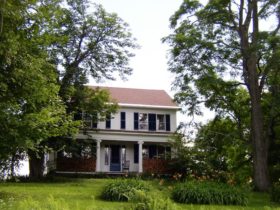 [Main Street] The Ingalls House was built between 1835 and 1837 by Ebenezer Thatcher. His wife, Julia, was a daughter of General Henry Knox, hero of the Revolution and first Secretary of War of the United States. During the 1870s it was the residence of Hannibal Ingalls, a prominent Mercer businessman.
[Main Street] The Ingalls House was built between 1835 and 1837 by Ebenezer Thatcher. His wife, Julia, was a daughter of General Henry Knox, hero of the Revolution and first Secretary of War of the United States. During the 1870s it was the residence of Hannibal Ingalls, a prominent Mercer businessman.
This Greek Revival structure with columned porch and traditional New England interior is a charming and quietly impressive piece of rural architecture. Of particular interest for its time and place is the unusually early accommodation to stove heating rather than the traditional reliance on fireplaces. While many houses of the period were later adapted to this modern heating device, it is clear that the Ingalls House was designed for stove heat. This departure from the traditional conservatism of Central Maine is noteworthy and an indication that by the 1830s modernity was no longer a stranger to what had very lately been a frontier.
Thatcher, Henry Knox, House
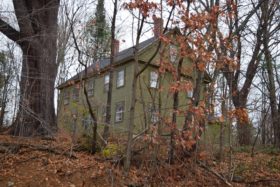 [Old Maine Route 3 (Main Street) and Elm Street; N44° 40′ 40.69″ W69° 56′ 4.57″] The Henry Knox Thatcher House was the on-shore residence of a career Naval officer whose prominence in the Navy during the 19th century rivaled that of his grandfather, General Henry Knox, in the Revolution. Thatcher was the son of Lucy Knox Thatcher (daughter of General Knox) and Judge Ebenezer Thatcher. The family originally lived in Thomaston Maine, where Henry Thatcher attended school before enrolling in West Point in 1822, and joining the Navy in 1823.
[Old Maine Route 3 (Main Street) and Elm Street; N44° 40′ 40.69″ W69° 56′ 4.57″] The Henry Knox Thatcher House was the on-shore residence of a career Naval officer whose prominence in the Navy during the 19th century rivaled that of his grandfather, General Henry Knox, in the Revolution. Thatcher was the son of Lucy Knox Thatcher (daughter of General Knox) and Judge Ebenezer Thatcher. The family originally lived in Thomaston Maine, where Henry Thatcher attended school before enrolling in West Point in 1822, and joining the Navy in 1823.
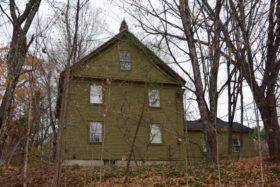 In 1829 Judge and Lucy Thatcher bought a lot in Mercer, where they built the Ingalls house seven years later. Henry’s earliest visit to Mercer is unknown: Naval records indicate he was at sea frequently during the years 1824 to 1829. In December 1831 he married Susan Crosswell of Mercer, and the following year purchased the house at the corner of Beech Hill Road and Elm Street. The house has both Federal style and Greek Revival elements, the result of an addition to the original Federal portion. It was to this house that Henry Knox Thatcher returned during his leaves and furloughs as he rose through the Naval ranks from midshipman to Commander over the next 38 years.
In 1829 Judge and Lucy Thatcher bought a lot in Mercer, where they built the Ingalls house seven years later. Henry’s earliest visit to Mercer is unknown: Naval records indicate he was at sea frequently during the years 1824 to 1829. In December 1831 he married Susan Crosswell of Mercer, and the following year purchased the house at the corner of Beech Hill Road and Elm Street. The house has both Federal style and Greek Revival elements, the result of an addition to the original Federal portion. It was to this house that Henry Knox Thatcher returned during his leaves and furloughs as he rose through the Naval ranks from midshipman to Commander over the next 38 years.
He had already attained the rank of acting master on the schooner Porpoise in the West Indies before moving to Mercer. In 1832 he was promoted to Lieutenant, and prior to becoming an inspector at the Charleston Navy Yard in Boston (1841 to 1847), he served on three additional ships, the Falmouth, the Erie and the Brandywine in the West Indies and the Mediterranean. Between 1847 and 1860 Thatcher continued to alternate shore jobs with time at sea.
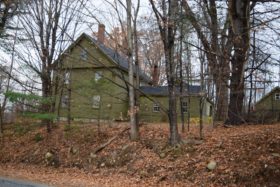 The Thatchers sold the property to Hiram Knowlton in 1860, and left Mercer. For the first two years of the Civil War, Thatcher patrolled the Mediterranean on the Constellation, after which he was promoted to Commodore and sent to the Gulf Coast aboard the Colorado. Over the next three years Thatcher was instrumental within the North Atlantic Blockading Squadron. He led a division in attacking Fort Fisher in North Carolina before assuming command of the West Gulf Blockading Squadron as acting Rear Admiral. During the final year of the war Thatcher attacked Mobile and accepted the Confederacy’s surrender on the Tombigbee River. He then went on to blockade the Texas coast, occupy Galveston, and was then given the command of the Gulf Squadron. After the war, Thatcher was made the Rear Admiral of the North Pacific Squadron, until his retirement in 1868. As a ‘retired officer’ Admiral Thatcher was the Port Admiral and station commander in Portsmouth from 1869-1870.
The Thatchers sold the property to Hiram Knowlton in 1860, and left Mercer. For the first two years of the Civil War, Thatcher patrolled the Mediterranean on the Constellation, after which he was promoted to Commodore and sent to the Gulf Coast aboard the Colorado. Over the next three years Thatcher was instrumental within the North Atlantic Blockading Squadron. He led a division in attacking Fort Fisher in North Carolina before assuming command of the West Gulf Blockading Squadron as acting Rear Admiral. During the final year of the war Thatcher attacked Mobile and accepted the Confederacy’s surrender on the Tombigbee River. He then went on to blockade the Texas coast, occupy Galveston, and was then given the command of the Gulf Squadron. After the war, Thatcher was made the Rear Admiral of the North Pacific Squadron, until his retirement in 1868. As a ‘retired officer’ Admiral Thatcher was the Port Admiral and station commander in Portsmouth from 1869-1870.
Mercer Union Meetinghouse
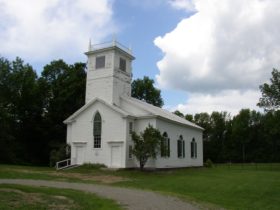 [Main Street, .1 miles West of Route 2] Built in 1829, the Meetinghouse is a transitional Federal and Greek Revival style frame building, detailed on the exterior with Gothic Revival style features and on the interior with Greek Revival moldings and bold grain painting.
[Main Street, .1 miles West of Route 2] Built in 1829, the Meetinghouse is a transitional Federal and Greek Revival style frame building, detailed on the exterior with Gothic Revival style features and on the interior with Greek Revival moldings and bold grain painting.
The Meetinghouse was a joint venture by the residents of the town and the members of the Congregational and Methodist societies. The three united to build a new meetinghouse that would seat three hundred parishioners. There were fifty-five pews sold to help pay for the construction. Reverand J.B. Husted of the Bath Congregational Church preached the dedication services on June 11, 1829. The deed to the land stipulated “that the Methodists and Congregationalists shall or may occupy or use the pulpit for preaching 7/16 of the Sabbaths during the year, on the other 2/16 of the Sabbaths, the pulpit is to be at the disposal of the individuals not belonging to the above mentioned orders who assisted in building said house by purchasing pews.”
During the first thirty years the church enjoyed great harmony but then discord set in and a great deal of unrest existed for years. In the decades after the Meetinghouse was erected both denominations built separate vestry buildings in the village, in part because the large Meetinghouse was hard to heat in the winter. In 1857 the Ladies Sewing Circle raised the funds for a church bell, which was installed that year.
By the turn of the century the Congregational society had diminished and after the loss of their chapel the group apparently folded and the Methodists again started to use the Meetinghouse on a seasonal basis. However, by 1916 the structure had one again fallen into disrepair. The Mercer Union Meetinghouse is one of a relatively small number of surviving Federal style religious buildings in Maine that are characterized by a central pavilion which projects from the main block, and a tower that either rises thorough or straddles both sections.


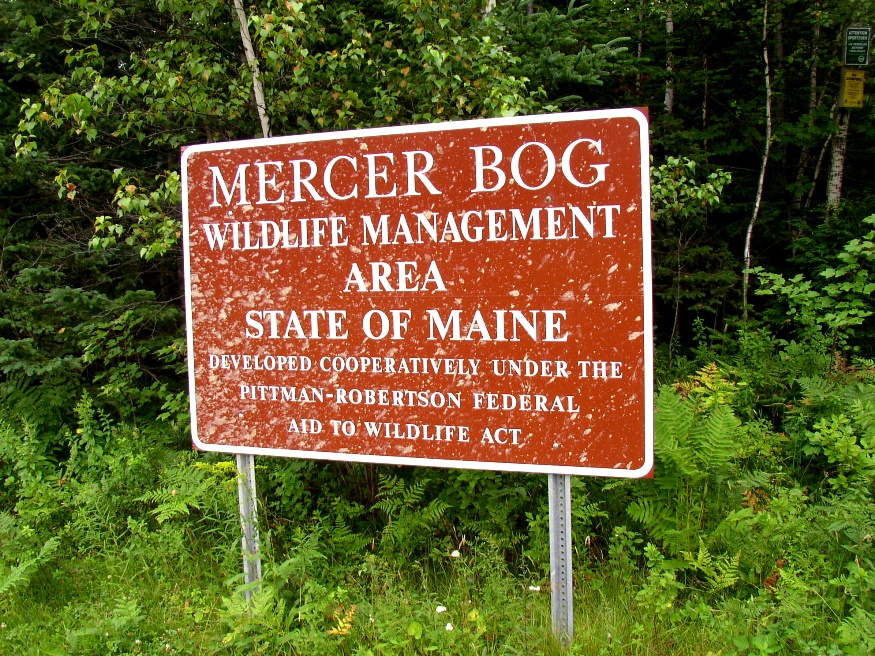
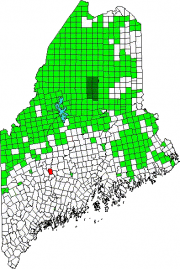
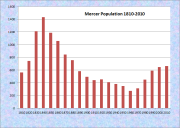
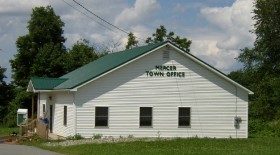
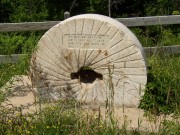
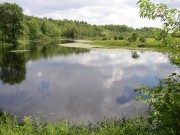
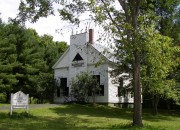

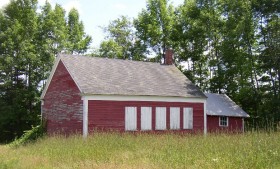
![The Washington School House in East Mercer [now removed] (2003) The Washington School House in East Mercer [now removed] (2003)](https://maineanencyclopedia.com/wp-content/uploads/mercer08-280x210.jpg)
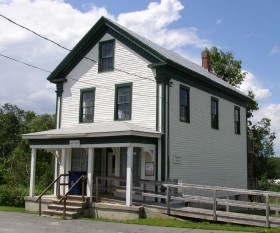
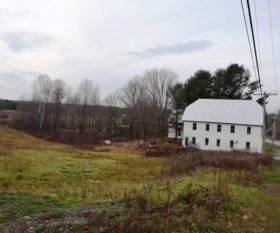

My Mother, Marjorie Wood, was born in Mercer in 1910. They lived next door to Helen True. My Mother’s parents were Carrie Sabra Allen and Frank Edgar Wood, both graduates of Colby College. Carrie and her brother Kelsey were teachers in Mercer, and were the children of Stephen Allen and Sabra Hinckley, also of Mercer. I visited Mercer all too briefly, 17 months ago, when my husband Allen and I attended our 50th Colby reunion. I believe Sabra was the daughter of Josiah Hinckley.
I found the graves of my great-grandparents and my mother’s brother Philip Wood, who died in infancy. They are buried beside the Meeting House on Norridgewock Road. I long to go back someday. Stephen was head of the grange hall, was a farmer and a well-known educator, having been in charge of schools up and down the Kennebec River area. I believe he served Mercer in the legislature. They were all good people. I would love to attend the August 3rd dinner sometime, but I live in North Carolina, so far away. My best wishes to everyone there. I’m sure I must have many distant relatives in Mercer. My grandmother spoke fondly of Mercer all the time.
Thanks for your attention.
Hi, I’m a decedent of Nicholas Kimball and Betsey Williamson. Nicholas removed to Maine as a young man where he took up land along the Sandy River at what later became Starks, Somerset County in the year 1788. It is said that he lived in a log cabin until he purchased the land ( 100 acres ) from the Kennebec Proprietors on February 16th 1804 for $85 and put up a framed house. This house still stands at the end of Elm street Mercer and is owned by the True family who inherited it from their forebears after it was passed onto the Burr family by Nicholas’ grandson David for their care after he fell ill in his last years. The farm was many in the area that produced a variety of crops such as apples, potatoes, maple syrup, honey & fish from the Bog Stream & Sandy River. I visited the farm in 1995 when it was a dairy owned by Billy True.
Nicholas was a Master carpenter at many house & barn raising bees.
He was also renowned for his skill as a horse trainer which he past on to his sons.
Nicholas was a member of the Methodist Church and served in Captain John Greenleafs’ Co. of the Starks Militia in the war of 1812 along with his son David. David’s brother Hartley Kimball lived a little back toward the village also in Elm Street ( known as Chicken Run ) Hartley’s son Cyrus Kimball is listed on the 1850 census (page 26) of Mercer, Somerset County, Maine ( USA ) as living at the Tucker family home two doors down Elm street from his parents home. It is said he left home in the early 1850’s in pursuit of gold in the California Gold Rush and after having no luck there he headed for the Victorian gold fields in Australia. He arrived sometime between 1852 and1859. Unfortunately he never did strike it rich. He made his living supplying diggers with goods and running a post office and erecting buildings along with horse training.
The Kimballs’ married into the Greenleaf, Williamson, and Curtis families. There are many headstones in the Mercer Village Cemetery.